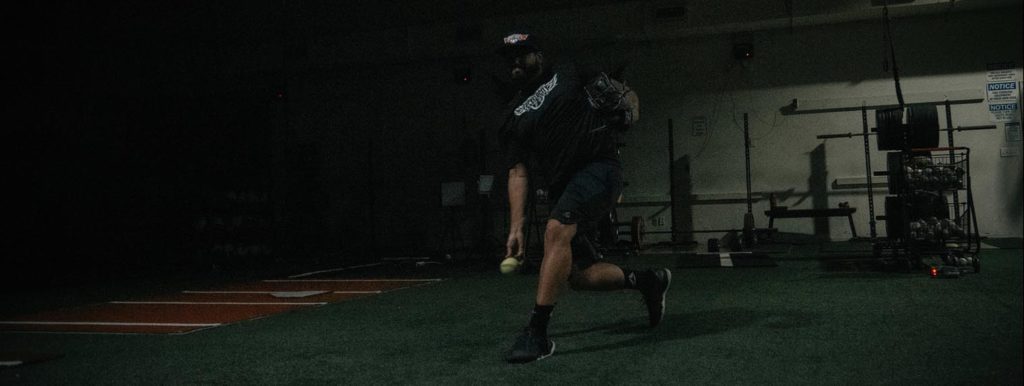
The 8 pitching mechanics to increase fastpitch softball velocity are listed below but before you jump down you need to learn a few important things before you can benefit from this information. What you need to learn may be a challenge to your current position on your softball team.
Warning, this is not conventional wisdom! This is actual science-based research defining the correlation of body movements to ball velocity. This means this isn't theory like most pitching coaches and programs use but actual facts of how fast pitch softball pitchers throw hard. You will learn very quickly that most of what you have been taught may not be actual facts in defining effective movement patterns for fastpitch pitchers.
In this article, we will look at the pitching mechanics of softball pitchers that correlate or link to increases in fast pitch velocity. We will use documented case studies to prove these findings along with the experience I have had with training pitchers in the 3X Fastpitch Softball Velocity Program. This article will only address the pitching mechanics and will not go into detail about what training is necessary to make these improvements in your delivery. I recommend you use the 3X Fastpitch Softball Velocity Program for this. purpose.
8 Softball Fastpitch Mechanics to Increase Velocity
These pitching mechanics components come from the three case studies cited at the bottom of the article. These three studies tested over 80 softball pitchers to discover these differences. Here is the complete list and a detailed understanding of how they fit into the entire fastpitch delivery.
- More Load on the Landing Leg - High-velocity pitchers will generate more ground reaction forces from the landing leg as it projects out towards the target. To perform this it has everything to do with how you load it into your posterior chain. This is why deadlifts are great for training this loading of the leg. In the 3X Fastpitch Velocity Program, we also train this movement with deadlifts and the Load to Launch dry drills.
- More Load into the Drive Leg - As the landing leg is kicking forward high-velocity pitchers will load to explode the drive leg. High-velocity pitchers will peak more ground reaction forces from the drive leg as well.
- The Time of Landing Leg to Drive Leg Forces - High-velocity pitchers will also time the peak ground reaction forces of both the landing leg load to explode and the drive leg load to explode later in the movement pattern. It not only takes drills to teach this but lower body power. The 3X Fastpitch Velocity Program will not only give you the drills to teach the movements but also the lifts and exercises to develop the elite power to enhance your load-to-explode movements.
- More Kick to Launch Landing Leg - The more you can drive your landing leg toward the target the more stride length will be increased. High-velocity pitchers have more stride length than low-velocity pitchers. The other component to increase stride length is the drive leg.
- More Drive from Drive Leg - The drive leg is just as responsible for stride length as the landing or kick leg. This is the dominant component that is moving your center of mass and pitchers who can move their center of mass more explosively are the harder-throwing pitchers.
- Quicker Stop with Landing Leg - Just as important is it to move your center of mass as explosive as possible it is to brake or stop this movement immediately at front foot strike. High-velocity fastpitch softball pitcher stops their movements even faster than in the baseball pitching delivery. On average softball fastpitch pitchers land in 30 degrees of landing leg flexion and peak their ground reaction forces well above their body weight.
- More Hip-to-Shoulder Separation - If you have elite lower body power and the correct timing to enhance this power up the body then you must master hip-to-shoulder separation, if you want to get all this energy into the ball. This is the icing on the cake and most low-velocity pitchers really struggle here once they develop the leg power. This occurs at front foot strike when the hips are open and the shoulders are still closed with the arm in the peak of its backswing. This separation gives the energy time to transfer up the body and it also multiplies forces as the core and trunk stretch into counter-rotation.
- More Trunk Extension at Front Foot Strike - High velocity pitchers once they separate hips to shoulders they will then fire the trunk into extension to push all of the energy from the body into the arm. This extension or deceleration of the trunk moves all movement to the arms just like stabilizing the core moves more energy into the ground.
The #1 Fastpitch Softball Program to Increase Velocity
 Now that you have 8 key pitching mechanic components to help you increase your fastpitch velocity you will need a program to help you develop them. Do not fall into the conventional wisdom now that these mechanics will improve from just throwing or running alone. You must use drills developed to teach these movements along with the lifts and exercises that support the movements as well as in a periodized training manual. This is why I developed the 3X Fastpitch Softball Velocity Program to help pitchers who don't have the genetic potential to naturally develop these movements.
Now that you have 8 key pitching mechanic components to help you increase your fastpitch velocity you will need a program to help you develop them. Do not fall into the conventional wisdom now that these mechanics will improve from just throwing or running alone. You must use drills developed to teach these movements along with the lifts and exercises that support the movements as well as in a periodized training manual. This is why I developed the 3X Fastpitch Softball Velocity Program to help pitchers who don't have the genetic potential to naturally develop these movements.
The 3X Fastpitch Softball Velocity Program uses a 3-calendar system to do this. It comes with a proprietary drill-based training system to train these mechanics along with the strength and anaerobic conditioning programs to develop the better athlete who can more easily achieve them. If you want to learn more about this revolutionary approach to increasing fastpitch velocity check it out NOW or get the program started TODAY!
Fastpitch Softball References
- Stephanie Spomer, Caroline Conley, and Michael Bird - A COMPARISON OF HIGH AND LOW VELOCITY PITCHERS IN FASTPITCH SOFTBALL - Truman State University, Kirksville, Missouri USA
- JOHN A. GUIDO, JR, SHERRY L. WERNER AND KEITH MEISTER - LOWER-EXTREMITY GROUND REACTION FORCES IN YOUTH WINDMILL SOFTBALL PITCHERS - Texas Metroplex Institute for Sports Performance, Grand Prairie, Texas 75050; and Texas Metroplex Institute for Sports Medicine, Arlington, Texas 76014
- Sophia Nimphius, Michael R. McGuigan, Timothy J. Suchomel, Robert U. Newton - Variability of a ‘‘force signature” during windmill softball pitching and relationship between discrete force variables and pitch velocity - Centre for Exercise and Sports Science Research, Edith Cowan University, Joondalup, WA 6027, Australia




